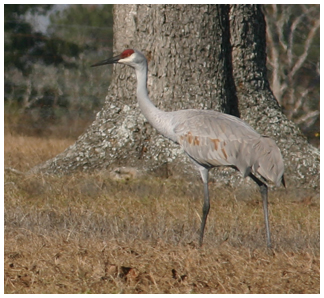
Winter visitors a welcome sight for local bird lovers
Clara Pittman of North Walton County looks forward to the special wintering guests she enjoys watching arrive in late fall. For the last five years, sandhill cranes have been migrating to the wetlands near her home just south of Lake Jackson in North Walton.
Typically arriving in mid-December and staying until mid-March, the cranes are a welcome sight, and have been flocking to the area in large numbers.
“I have seen as many a three dozen in the wetlands; I enjoy watching them,” Clara said.
With a wingspan of up to 78 inches and standing more than 3 feet tall, the sandhill crane (Grus canadensis) is one of the largest birds in North America. There are several subspecies of the sandhill crane with the Lesser Sandhill (Northern) migrating from the northern U.S. and the Greater Sandhill (Southern) year-round residents in southern Florida.

Sandhill cranes are omnivores, eating mostly grains and seeds, some insects, other invertebrates, and small vertebrates. The cranes are primarily birds of open fresh water wetlands, but the different subspecies utilize habitats that range from bogs, meadows, and open grasslands.
Sandhill Cranes are heavy bodied, long-necked, long-legged birds with bugling calls, often heard well before the birds are seen, and for their elaborate courtship dancing. They are among the oldest living birds.
Unison call: Click here
Contact call: Click here
Information courtesy National Audubon Society, Cornell Lab or Ornithology, and International Crane Foundation.
